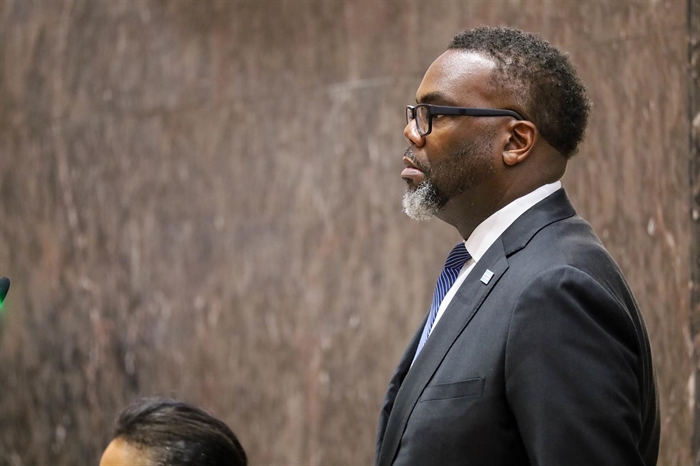(Photo credit Andrew Adams)
By ANDREW ADAMS
Capitol News Illinois
The state and Cook County announced Thursday a roughly $250 million plan to provide shelter, health care and other services for recently arrived migrants. But according to their own plan, there’s still a roughly $70 million funding gap for the rest of 2024.
That missing money could come from Chicago, although a proposal for additional funding has not been brought to Chicago’s city council.
At a Thursday news conference, Chicago Mayor Brandon Johnson did not indicate any plans for the city to fill the remaining budget gap, noting that a lack of federal intervention could be an “incredible burden for the city of Chicago.”
A source briefed on the matter told Capitol News Illinois Johnson had committed to providing the remaining funds at a Feb. 5 meeting between the mayor, governor and Cook County Board President Toni Preckwinkle.
When he was asked about this on Thursday, Johnson said he was “not aware” of any deal between the three, also adding that “there is no disconnect” between his administration and Pritzker’s.
In a Thursday news release, the governor’s office said the state’s portion funding will come from the state’s fiscal year 2025 budget.
Gov. JB Pritzker, who committed the state to providing more than half of the needed funds, is expected to provide more detail about where the money is coming from next Wednesday in his annual budget address.
With thousands of asylum seekers continuing to come to Chicago in desperate need of support and with Congress continuing to refuse to act — it is clear the state, county, and city will have to do more to keep people safe
Gov JB Pritzker
House Democrats’ chief budget negotiator, Rep. Jehan Gordon Booth, D-Peoria, and the head of a working group focused on recently arrived migrants, Rep. Jennifer Gong-Gershowitz, D-Glenview, told Capitol News Illinois in a joint statement they will review the full details of the state’s portion of the spending plan next week.
“We will remain focused on continuing to bring stakeholders together to continue making smart and compassionate decisions for our state and all of our communities,” they said.
In December, following a Governor’s Office of Management and Budget forecast, the governor urged caution for this year’s budgeting process. That office projected a potential $891 million deficit for the upcoming fiscal year. But GOMB also predicted a $1.4 billion surplus for the current fiscal year, due to several one-time revenue streams.
In a statement, Pritzker indicated disappointment at the lack of a coordinated federal response to the influx of migrants.
“With thousands of asylum seekers continuing to come to Chicago in desperate need of support and with Congress continuing to refuse to act — it is clear the state, county, and city will have to do more to keep people safe,” Pritzker said.
Pritzker has been outspoken in calling for more federal involvement, repeatedly calling on President Joe Biden and congressional leaders to designate a federal office to coordinate the nation’s migrant response and provide additional resources.
“As critical funding for this ongoing humanitarian crisis stalls in Congress, Cook County stands committed to the well-being of the region,” Preckwinkle said in a news release. “We cannot wait for additional resources and Cook County is proud to stand alongside Governor Pritzker in this joint funding plan, ensuring that shelter capacity, healthcare and wraparound services remain accessible to those in need.”
A compromise deal in the U.S. Senate that was meant to help address the increase in border crossings disintegrated last week after Republicans backed out of the agreement.
The state in November committed to a $160 million spending plan, although portions of that plan – such as a 2,000 bed shelter in Chicago – have yet to come to fruition.
The state also claims that it has spent $478 million through existing channels, such as through the Illinois Emergency Management Agency, over the past two years.
The influx of migrants coming from Texas has slowed in recent weeks, with Chicago’s shelter system being at its lowest capacity since last fall. As of Wednesday, there were about 12,900 people staying in city shelters – down from a peak of around 15,000 a few weeks ago.
There were also no migrants at the city’s airports or at the “landing zone” facility, the location that the city instructs bus companies to drop people off.









